Themed collection Nanozymes

Introduction to nanozymes
This Editorial written by Guest Editors Professors Shaoqin Liu, Vincent Rotello, Asier Unciti-Broceta and Hui Wei introduces the themed collection on nanozymes in Journal of Materials Chemistry B and Nanoscale.

J. Mater. Chem. B, 2023,11, 10979-10981
https://doi.org/10.1039/D3TB90199H
Peroxidase mimics of platinum-group metals for in vitro diagnostics: opportunities and challenges
This perspective discusses fundamentally important issues and practically useful viewpoints of platinum-group metal peroxidase mimics from the aspects of materials science and solid-state chemistry.

J. Mater. Chem. B, 2023,11, 8404-8410
https://doi.org/10.1039/D3TB01255G
An emerging direction for nanozyme design: from single-atom to dual-atomic-site catalysts
This mini-review captures the emerging direction of nanozymes and presents a comprehensive overview of dual-atomic site nanozymes. It guides the exploration of next-generation nanozymes and inspires further innovation in the field.

Nanoscale, 2023,15, 18173-18183
https://doi.org/10.1039/D3NR04853E
Advances in the application of metal–organic framework nanozymes in colorimetric sensing of heavy metal ions
In this minireview, the preparation methods and catalytic mechanisms of MOFs-based nanozymes were mainly described. Furthermore, the applications of MOFs-based nanozymes in the colorimetric sensing platform of heavy metal ions were demonstrated.
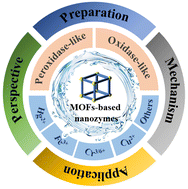
Nanoscale, 2023,15, 12853-12867
https://doi.org/10.1039/D3NR02024J
Nanozyme: a rising star for cancer therapy
Tumor therapy by nanozymes.
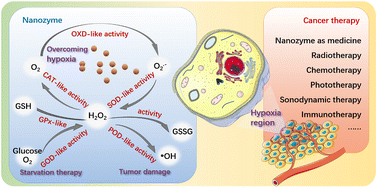
Nanoscale, 2023,15, 12455-12463
https://doi.org/10.1039/D3NR01976D
Enhancing electrochemical sensing through the use of functionalized graphene composites as nanozymes
+ Different categories of artificial enzymes (nanozymes) according to the type of graphene derivative.

Nanoscale, 2023,15, 16514-16538
https://doi.org/10.1039/D3NR01998E
Single-atom nanozymes: classification, regulation strategy, and safety concerns
This review categorizes and describes the applications of SAzymes, explores methods for regulating their activity, and provides a comprehensive overview of the biosafety challenges associated with these enzymes.

J. Mater. Chem. B, 2023,11, 9840-9866
https://doi.org/10.1039/D3TB01644G
Cascade strategy for glucose oxidase-based synergistic cancer therapy using nanomaterials
Nanomaterial-based cancer therapy faces significant limitations due to the complex nature of the tumor microenvironment (TME).
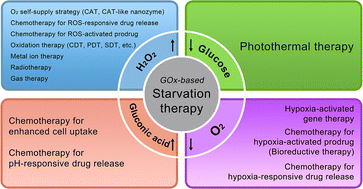
J. Mater. Chem. B, 2023,11, 9798-9839
https://doi.org/10.1039/D3TB01325A
Nucleic acid-functionalized nanozymes and their applications
Nucleic acid-modified nanozymes provide hybrid nanostructures that act as sensors, effective catalysts and bioreactor systems, DNA switches and catalysts for nano-biomedical applications.
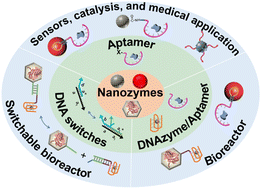
Nanoscale, 2023,15, 14301-14318
https://doi.org/10.1039/D3NR02345A
Anti-inflammatory potential of platinum nanozymes: mechanisms and perspectives
PtNPs hold great potential as anti-inflammatory agents, regulating the ROS-mediated recruitment and activation of immune system components.

Nanoscale, 2023,15, 14284-14300
https://doi.org/10.1039/D3NR03016D
Antioxidative 0-dimensional nanodrugs overcome obstacles in AKI antioxidant therapy
Schematic illustration of 0D nanodrugs for AKI treatment. (a) Pathological features of renal tubular injury and glomerular filtration barrier in AKI. (b) Three categories of 0D nanomaterials applied to nanodrugs surrounding AKI antioxidant therapy.

J. Mater. Chem. B, 2023,11, 8081-8095
https://doi.org/10.1039/D3TB00970J
Antioxidant nanozymes in kidney injury: mechanism and application
Excessive production of reactive oxygen species (ROS) in the kidneys is involved in the pathogenesis of kidney diseases, such as acute kidney injury (AKI) and diabetic kidney disease (DKD), and is the main reason for the progression of kidney injury.

Nanoscale, 2023,15, 13148-13171
https://doi.org/10.1039/D3NR01954C
Prussian blue nanozymes: progress, challenges, and opportunities
Prussian blue nanozymes: unlocking new horizons in catalysis and biomedicine – a comprehensive review of the progress, addressing challenges, and exploring limitless opportunities.

Nanoscale, 2023,15, 12818-12839
https://doi.org/10.1039/D3NR01741A
Advances and perspectives of nanozymes in respiratory diseases
This is a systematic review of advances and perspectives of nanozymes in respiratory diseases, which will inspire communities of researchers and build a bridge between nanozymes and respiratory medicine.

J. Mater. Chem. B, 2023,11, 7041-7054
https://doi.org/10.1039/D3TB00930K
Development of nanozyme based sensors as diagnostic tools in clinic applications: a review
Nanozyme-based sensors in the field of healthcare.

J. Mater. Chem. B, 2023,11, 6762-6781
https://doi.org/10.1039/D3TB00451A
Recent progress in nanozymes for the treatment of diabetic wounds
In this review, the recent advance in nanozymes to promote diabetic wound healing was summarized from bacterial clearance, glucoregulation, and inflammation elimination.

J. Mater. Chem. B, 2023,11, 6746-6761
https://doi.org/10.1039/D3TB00803G
Machine learning facilitating the rational design of nanozymes
Nanozymes face challenges in creating high-performance variants quickly. Machine learning shows promise in addressing this obstacle by predicting the activity, selectivity, catalytic mechanisms, optimal structures, and other features of nanozymes.

J. Mater. Chem. B, 2023,11, 6466-6477
https://doi.org/10.1039/D3TB00842H
The rational design of nanozymes for imaging-monitored cancer therapy
Nanomaterial-based nanozymes with the activities of different natural enzymes have been applied in tumor therapy and multiple imaging tools to monitor the catalytic activities.

J. Mater. Chem. B, 2023,11, 5933-5952
https://doi.org/10.1039/D3TB00464C
Design of carbon dots as nanozymes to mediate redox biological processes
Fluorescent carbon dot nanozymes with multi-enzyme activities can mediate redox biological processes. Various strategies which mimic natural enzymes can be used to improve their catalytic activity and specificity.

J. Mater. Chem. B, 2023,11, 5071-5082
https://doi.org/10.1039/D2TB02259A
Ferritin nanocages: a versatile platform for nanozyme design
Overview of ferritin nanocage and ferritin nanozyme. The ferritin nanocages hold different modified interfaces of protein structure (upper). Ferritin nanozymes show various enzyme-like activities for different biomedical applications (bottom).

J. Mater. Chem. B, 2023,11, 4153-4170
https://doi.org/10.1039/D3TB00192J
CuCeTA nanoflowers as an efficient peroxidase candidate for direct colorimetric detection of glyphosate
A CuCeTA nanozyme was designed as a peroxidase mimic for intelligent colorimetric detection of glyphosate.

J. Mater. Chem. B, 2023,11, 9630-9638
https://doi.org/10.1039/D3TB01455J
Amplification of oxidative stress by lipid surface-coated single-atom Au nanozymes for oral cancer photodynamic therapy
Single-atom nanozymes (SANs) are the latest trend in biomaterials research and promote the application of single atoms in biological fields and the realization of protein catalysis in vivo with inorganic nanoparticles.

Nanoscale, 2023,15, 15558-15572
https://doi.org/10.1039/D3NR02088F
Tuning the enzyme-like activity of peptide–nanoparticle conjugates with amino acid sequences
Peptide–nanoparticle conjugates show hydrolase-like activity, which is tuned by amino acid sequences.
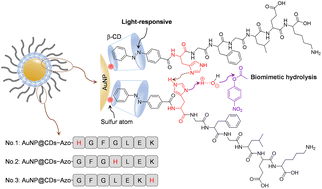
Nanoscale, 2023,15, 8148-8152
https://doi.org/10.1039/D3NR00171G
A cascade nanozyme with antimicrobial effects against nontypeable Haemophilus influenzae
A cascade nanozyme with glucose oxidase and haloperoxidase activities was designed and synthesized, which was shown to generate antiseptic HOBr from a ubiquitous non-ROS, O2. It successfully inhibited growth of a bacterial pathogen and its biofilm.

Nanoscale, 2023,15, 1014-1023
https://doi.org/10.1039/D2NR04306H
Design of a gold nanoparticles site in an engineered lipase: an artificial metalloenzyme with enantioselective reductase-like activity
A new approach for the synthesis of gold nanoparticles-enzyme conjugates with enantioselective reductase-like activity has been developed.

Nanoscale, 2024,16, 6999-7010
https://doi.org/10.1039/D4NR00573B
Diagnosis of Mycobacterium tuberculosis using palladium–platinum bimetallic nanoparticles combined with paper-based analytical devices
This study demonstrates that palladium–platinum bimetallic nanoparticles (Pd@Pt NPs) can be used as the nanozyme for highly sensitive Mycobacterium tuberculosis diagnosis on a multi-layer paper-based analytical device.

Nanoscale, 2024,16, 5988-5998
https://doi.org/10.1039/D3NR05508F
Construction of a highly efficient DNA nanotube sensor with peroxide-like activity
DNTzyme with enhanced enzymatic activity and excellent stability was constructed by loading of DNAzyme on DNA nanotubes.

J. Mater. Chem. B, 2024,12, 240-249
https://doi.org/10.1039/D3TB01984E
Mitochondria-targeting nanozyme alleviating temporomandibular joint pain by inhibiting the TNFα/NF-κB/NEAT1 pathway
Mitochondria-targeting MOF-based nanozyme alleviating temporomandibular joint pain by inhibiting the TNFα/NF-κB/NEAT1 pathway based on oxidative stress regulation.

J. Mater. Chem. B, 2024,12, 112-121
https://doi.org/10.1039/D3TB00929G
2D-MoS2-supported copper peroxide nanodots with enhanced nanozyme activity: application in antibacterial activity
Peroxidase (POD)-like nanozymes are an upcoming class of new-generation antibiotics that are efficient for broad-spectrum antibacterial action.

Nanoscale, 2023,15, 19801-19814
https://doi.org/10.1039/D3NR05458F
Ultrasmall calcium-enriched Prussian blue nanozymes promote chronic wound healing by remodeling the wound microenvironment
Ultrasmall CaPB NPs fabricated via a simple and feasible route with high yields have promising potential for accelerating wound healing through antioxidant activity, anti-inflammatory activity and vascularization promotion.

J. Mater. Chem. B, 2023,11, 11578-11587
https://doi.org/10.1039/D3TB02065G
Spherical porous iron–nitrogen–carbon nanozymes derived from a tannin coordination framework for the preparation of L-DOPA by emulating tyrosine hydroxylase
L-DOPA is widely used in Parkinson's disease treatment. A spherical porous Iron-Nitrogen-Carbon nanozyme was developed for biomimetic synthesis of L-DOPA by emulating tyrosine hydroxylase.

J. Mater. Chem. B, 2023,11, 11235-11250
https://doi.org/10.1039/D3TB01082A
A pH-responsive supramolecular hydrogel encapsulating a CuMnS nanoenzyme catalyst for synergistic photothermal–photodynamic–chemodynamic therapy of tumours
A pH-responsive supramolecular hydrogel encapsulating a CuMnS nanoenzyme catalyst was fabricated for synergistic photothermal–photodynamic–chemotherapy of tumours.

J. Mater. Chem. B, 2023,11, 10883-10895
https://doi.org/10.1039/D3TB01769A
Coal waste-derived synthesis of yellow oxidized graphene quantum dots with highly specific superoxide dismutase activity: characterization, kinetics, and biological studies
The remediation of coal waste into YGQDs with SOD-specific activity and superoxide ion binding in nanomolar range is reported for the first time. The molecular mechanism of its antioxidative and antiapoptotic properties are confirmed in C6-cells.

Nanoscale, 2023,15, 17861-17878
https://doi.org/10.1039/D3NR04259F
Ruptured organosilica nanocapsules immobilized acetylcholinesterase coupled with MnO2 nanozyme for screening inhibitors from Inula macrophylla
A platform of RONs immobilized AChE coupled with an MnO2-OPD colorimetric assay was established for screening inhibitors.

Nanoscale, 2023,15, 17464-17472
https://doi.org/10.1039/D3NR04025A
Exploring the potential of iron-based metal–organic frameworks as peroxidase nanozymes for glucose detection with various secondary building units
This study investigated different secondary building units of iron-based metal–organic frameworks and discovered that when combined with an enzyme-encapsulating ZIF-90 PVP MOF, they could be sequentially employed for glucose detection purposes.

J. Mater. Chem. B, 2023,11, 10362-10368
https://doi.org/10.1039/D3TB00981E
Nanozymes with versatile redox capabilities inspired in metalloenzymes
Engineered artificial metalloenzymes based on protein-templated Pt nanoclusters yield highly efficient nanozymes serving as redox catalysts.
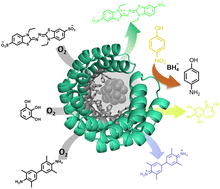
Nanoscale, 2023,15, 16959-16966
https://doi.org/10.1039/D3NR03443G
A nanozyme-reinforced injectable photodynamic hydrogel for combating biofilm infection
Here, an oxygen self-supplying nanozyme-based injectable hydrogel is constructed. Both in vitro and in vivo results indicate that the MTC gel has excellent antibiofilm ability with no side effects on normal tissues.

J. Mater. Chem. B, 2023,11, 10108-10120
https://doi.org/10.1039/D3TB01688A
Bismuth nanoclusters on nitrogen-doped porous carbon nanoenzyme for cancer therapy
We have designed a highly efficient bismuth nanocluster supported on nitrogen-doped porous carbon as a nanozyme (Bi-NC) for cancer therapy. At the same time, Bi-NC shows good photothermal conversion performance to generate heat for strengthening the therapy.

Nanoscale, 2023,15, 16619-16625
https://doi.org/10.1039/D3NR03957A
Tetrahedral DNA nanostructure-corbelled click chemistry-based large-scale assembly of nanozymes for ratiometric fluorescence assay of DNA methyltransferase activity
We engineer DTN-corbelled click chemistry to trigger a HCR assembling a large-scale of nanozymes for ratiometric fluorescence detection of DNA Dam. The biosensor displayed a low detection limit of 0.001 U mL−1 for Dam MTase and was effective in real sample and methylation inhibitor screenings.

J. Mater. Chem. B, 2023,11, 9912-9921
https://doi.org/10.1039/D3TB01795H
pH-Switchable phenylalanine-templated copper nanoclusters: CO2 probing and efficient peroxidase mimicking activity
Inter-cluster conversion through the strategic tuning of external stimuli and thereby modulation of the optical properties of metal nanoclusters (MNCs) is an emerging domain for exploration.

Nanoscale, 2023,15, 15368-15381
https://doi.org/10.1039/D3NR04195F
Polymeric architecture as a tool for controlling the reactivity of palladium(II) loaded nanoreactors
The architecture of the hydrophobic dendritic block in linear-dendron amphiphiles is employed as a means to control the reactivity of self-assembled micellar nanoreactors.

Nanoscale, 2023,15, 15396-15404
https://doi.org/10.1039/D3NR02012F
Fe(III)-incorporated porphyrin-based conjugated organic polymer as a peroxidase mimic for the sensitive determination of glucose and H2O2
An Fe(III)-incorporated porphyrin-based conjugated organic polymer is reported as a nanozyme for the efficient detection of glucose via intrinsic peroxidase activity and amperometric detection of H2O2.
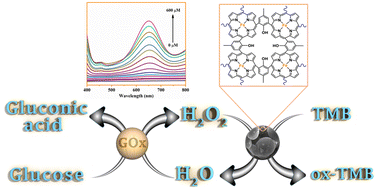
J. Mater. Chem. B, 2023,11, 8956-8965
https://doi.org/10.1039/D3TB00977G
Dual enzyme-mimicking carbon dots for enhanced antibacterial activity
Carbon dot (CD)-based nanozymes have great potential in antibacterial applications through the design of the structure.

J. Mater. Chem. B, 2023,11, 8916-8925
https://doi.org/10.1039/D3TB01376F
A tumor cell exosome-mimicking multifunctional nanozyme for targeted breast cancer radiotherapy
A multifunctional nanozyme that mimics tumor cell exosomes (CuPy-Au@EM) was fabricated in this work for achieving a highly effective and secure cancer radiotherapy regimen.
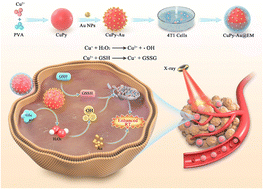
Nanoscale, 2023,15, 14949-14957
https://doi.org/10.1039/D3NR03065B
Light-gated specific oxidase-like activity of a self-assembled Pt(II) nanozyme for environmental remediation
A synthetic Pt(II) complex self-assembles in water, exhibiting photo-induced specific oxidase enzyme-like properties. We demonstrate robust environmental remediation using the artificial enzyme equivalent under visible light and sunlight.
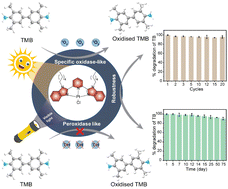
Nanoscale, 2023,15, 14809-14821
https://doi.org/10.1039/D3NR02081A
Conservation of the enzyme-like activity and biocompatibility of CeO2 nanozymes in simulated body fluids
CeO2 nanozymes dispersed for 7 days in simulated body fluids maintain excellent biocompatibility and antioxidant properties. This work provides an experimental basis to explain their in vivo therapeutic effectiveness against chronic inflammation.

Nanoscale, 2023,15, 14365-14379
https://doi.org/10.1039/D3NR03524G
Platinum-based nanodendrites as glucose oxidase-mimicking surrogates
Defining Pt nanodendrites as glucose oxidase-mimicking surrogates while establishing the most suitable calculation and detection approaches.
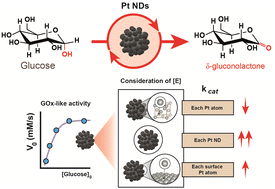
Nanoscale, 2023,15, 14399-14408
https://doi.org/10.1039/D3NR02026F
NiCo LDH nanozymes with selective antibacterial activity against Gram-negative bacteria for wound healing
Schematic diagram of Ni4Co6 LDHs selectively killing Gram-negative bacteria and interacting with different bacterial membranes.

J. Mater. Chem. B, 2023,11, 7675-7683
https://doi.org/10.1039/D3TB00957B
Targeted treatment of gouty arthritis by biomineralized metallic nanozyme-mediated oxidative stress-mitigating nanotherapy
Targeted delivery of ceria nanozymes depletes oxidative stress in inflammatory macrophage cells and alleviates gouty arthritis symptoms by suppressing inflammatory signals.
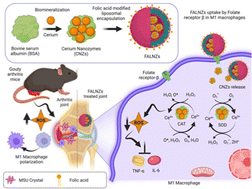
J. Mater. Chem. B, 2023,11, 7684-7695
https://doi.org/10.1039/D3TB00669G
Biodegradable nanoemulsion-based bioorthogonal nanocatalysts for intracellular generation of anticancer therapeutics
A biodegradable nanoemulsion to encapsulate hydrophobic transition metal catalysts (TMCs) and perform intracellular bioorthogonal activation of prodrugs for anticancer therapy.

Nanoscale, 2023,15, 13595-13602
https://doi.org/10.1039/D3NR01801F
Construction of mPt/ICG-αA nanoparticles with enhanced phototherapeutic activities for multidrug-resistant bacterial eradication and wound healing
Novel composite nanoparticles mPt/ICG-αA, which combine catalase-like, photodynamic, photothermal, and α-amylase hydrolysis properties, have been developed for multidrug-resistant bacterial eradication and wound healing.

Nanoscale, 2023,15, 13617-13627
https://doi.org/10.1039/D3NR02010J
A Ce-MOF@polydopamine composite nanozyme as an efficient scavenger for reactive oxygen species and iron in thalassemia disease therapy
A Ce-MOF@PDA composite material with both iron-eliminating and antioxidant properties was developed.

Nanoscale, 2023,15, 13574-13582
https://doi.org/10.1039/D3NR01971C
Pd nanocatalysts adsorbed onto silica nanoparticle coated indium tin oxide: a reusable nanozyme for glucose detection
Nanozymes based on the chemisorption of PdNPs nanocatalysts onto silica nanoparticles modified ITO for the colorimetric detection of glucose.

J. Mater. Chem. B, 2023,11, 7961-7971
https://doi.org/10.1039/D3TB00530E
Enhanced peroxidase-like activity of MOF nanozymes by co-catalysis for colorimetric detection of cholesterol
MoCu-2MI was synthesized using Mo-doped Cu-2MI and exhibited enhanced peroxidase-like activity through the co-catalytic Fenton reaction.

J. Mater. Chem. B, 2023,11, 7913-7919
https://doi.org/10.1039/D3TB00958K
DNA-modulated single-atom nanozymes with enhanced enzyme-like activity for ultrasensitive detection of dopamine
DNA can act as an auxiliary regulator via a straightforward incubation method with Fe–N–C SAzymes, causing a leap in the enzyme-like activity of Fe–N–C from moderate to a higher level.

Nanoscale, 2023,15, 13289-13296
https://doi.org/10.1039/D3NR01737K
Organic compound-based nanozymes for agricultural herbicide detection
Illustrated summary of the OC nanozyme and glyphosate detection with it.

Nanoscale, 2023,15, 12954-12960
https://doi.org/10.1039/D3NR02025H
Amphiphilic polymeric nanoparticles enable homogenous rhodium-catalysed NH insertion reactions in living cells
Hydrophobic dirhodium complexes embedded into amphiphilic nanoparticles catalyse efficiently the in vitro formation of fluorescent and cytotoxic quinoxalines.

Nanoscale, 2023,15, 12710-12717
https://doi.org/10.1039/D3NR02581K
A nucleotide–copper(II) complex possessing a monooxygenase-like catalytic function
We present a Cu2+-nucleotide catalyst that enables ortho-hydroxylation reactions of phenols. The results provide evidence for the generation of HO2• radicals facilitated by a hydrogen bonding network. Notably, this system demonstrates improved thermostability.

J. Mater. Chem. B, 2023,11, 7117-7125
https://doi.org/10.1039/D3TB00780D
Functionalized nanozyme with drug loading for enhanced tumour combination treatment of catalytic therapy and chemotherapy
We report the development of Zr/Ce-MOFs/DOX/MnO2 as a new nanozyme for enhanced combination catalytic therapy and chemotherapy of cancer in vitro and in vivo.

J. Mater. Chem. B, 2023,11, 6889-6895
https://doi.org/10.1039/D3TB01002C
Dual functionality of ferrocene-based metallopolymers as radical scavengers and nanoparticle stabilizing agents
The surface of latex nanoparticles was functionalized with ferrocene-based metallopolymers to obtain an efficient radical scavenger composite with remarkable colloidal stability.

Nanoscale, 2023,15, 11875-11883
https://doi.org/10.1039/D3NR02063K
Light-activated carbon dot nanozyme with scandium for a highly efficient and pH-universal bio-nanozyme cascade colorimetric assay
We report the Sc3+-boosted photocatalytic oxidation of C-dots based on strong coordination and electron transfer for constructing a cascade colorimetric assay at broad pH.

J. Mater. Chem. B, 2023,11, 6697-6703
https://doi.org/10.1039/D3TB00927K
A porphyrin-MOF-based integrated nanozyme system for catalytic cascades and light-enhanced synergistic amplification of cellular oxidative stress
An integrated iron-porphyrin-MOF-based nanozyme composite named HGPF was constructed for the intracellular glucose-initiated catalytic oxidation cascades and light-enhanced generation of ROS, synergistically amplifying cellular oxidative stress.

J. Mater. Chem. B, 2023,11, 6581-6594
https://doi.org/10.1039/D3TB00681F
Nanozyme-integrated microneedle patch for enhanced therapy of cutaneous squamous cell carcinoma by breaking the gap between H2O2 self-supplying chemodynamic therapy and photothermal therapy
A microneedle patch has been developed to bridge the gap between H2O2 self-supplying chemodynamic therapy and photothermal therapy, resulting in enhanced therapy of cutaneous squamous cell carcinoma.
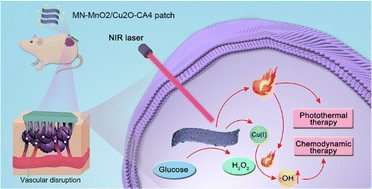
J. Mater. Chem. B, 2023,11, 6595-6602
https://doi.org/10.1039/D3TB00708A
Reactive oxygen species-mediated CuRuOX@HA hybrid nanozymes for multidrug-resistant bacterial infections with synergistic photothermal therapy
This study prepared a ROS-mediated copper-ruthenium oxide (CuRuOX) hybrid nanozyme (CuRuOX@HA) modified with hyaluronic acid (HA).

J. Mater. Chem. B, 2023,11, 5195-5206
https://doi.org/10.1039/D3TB00787A
A dual-nanozyme-loaded black phosphorus multifunctional therapeutic platform for combined photothermal/photodynamic/starvation cancer therapy
Schematic diagram of the construction of AMGP and its application in the combination therapy of tumors.

J. Mater. Chem. B, 2023,11, 5185-5194
https://doi.org/10.1039/D3TB00372H
Single-layer HNb3O8 with strong and nearby Lewis and Brønsted acid sites boosts amide bond hydrolysis for urease mimicking
Single-layer HNb3O8 with strong and nearby Lewis and Brønsted acid sites mimicking urease can excellently catalyze amide bond hydrolysis. This material even outperforms urease in urea hydrolysis at 50 °C due to its high thermal stability.

Nanoscale, 2023,15, 9752-9758
https://doi.org/10.1039/D3NR01262J
Fe3N-decorated porous carbon frameworks from wheat flour with dual enzyme-mimicking activities for organic pollutant degradation
Fe3N decorated on porous carbon frameworks via a one-step pyrolysis exhibited outstanding dual enzyme-mimicking activities for organic pollutant degradation and excess H2O2 removal without consuming additional resources and energy.

Nanoscale, 2023,15, 9718-9727
https://doi.org/10.1039/D3NR00048F
Nanozyme-catalyzed cascade reaction enables a highly sensitive detection of live bacteria
The Au@POM nanoparticles were facilely synthesized using a one-step method. The as-prepared Au@POMs have excellent GOx-like and HRP-like activities, allowing for fast cascade reactions and sensitive bacterial detections.

J. Mater. Chem. B, 2023,11, 4890-4898
https://doi.org/10.1039/D3TB00441D
Comparison of the peroxidase activities of iron oxide nanozyme with DNAzyme and horseradish peroxidase
A systematic comparison of three catalysts with peroxidase and peroxidase-like activities revealed the trend of activity, stability and the effect of buffer and pH for the oxidation of TMB.

Nanoscale, 2023,15, 8189-8196
https://doi.org/10.1039/D3NR01098H
Visual evaluation of acetylcholinesterase inhibition by an easy-to-operate assay based on N-doped carbon nanozyme with high stability and oxidase-like activity
We propose an easy-to-operate nanozyme assay for the visual evaluation of AChE inhibition.

J. Mater. Chem. B, 2023,11, 4014-4019
https://doi.org/10.1039/D3TB00238A
About this collection
Nanozymes are nanomaterials with enzyme-like characteristics. They have been developed to address the limitations of natural enzymes and conventional artificial enzymes. Along with the significant advances in nanotechnology, biotechnology, catalysis science, and computational design, great progress has been achieved in the field of nanozymes since the discovery of peroxidase-like iron oxide nanozyme in 2007. Nanozymes have been explored for a variety of applications, ranging from biosensing and therapeutics to environmental protection and national security. To our knowledge, more than 400 laboratories from 35 countries are working on nanozymes. Notably, both the publications and citations on nanozymes have been growing rapidly, showing the enormous research interest from the field.
This themed collection on ‘Nanozymes’ is Guest Edited by Prof. Shaoqin Liu (Harbin Institute of Technology, China), Prof. Vincent Rotello (University of Massachusetts, USA), Prof. Asier Unciti-Broceta (University of Edinburgh, UK) and Prof. Hui Wei (Nanjing University, China) and highlights some of the recent progress in the field of nanozymes from across Journal of Materials Chemistry B and Nanoscale.
We hope that this special collection will not only accelerate the development of the nanozyme field, but also attract more researchers to explore the hidden characteristics of nanomaterials for broad applications. Congratulations to all featured authors!